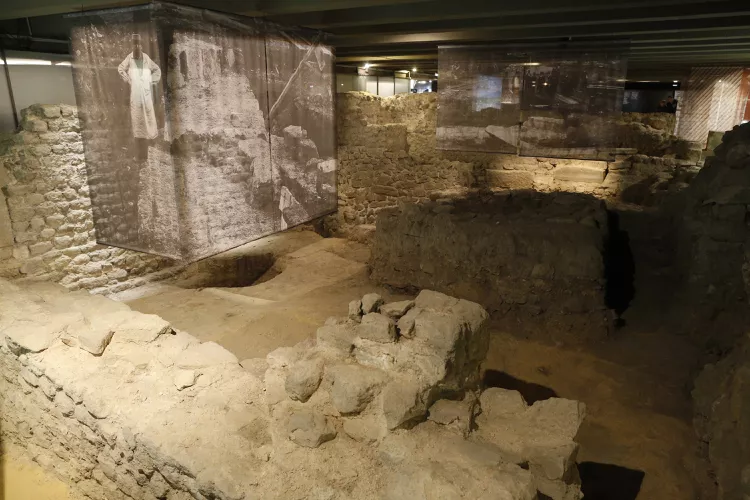Summary
With a history stretching back over 2,000 years, the Archaeological Crypt lying beneath the square of Paris’s famed Notre Dame Cathedral offers a fascinating glimpse into the rich and tumultuous history of the French capital.
Comprising remains discovered during archaeological excavations between 1965 and 1972, the archaeological crypt (Crypte Archaeologique du Parvis de Notre Dame) was inaugurated as a museum in 1980, delighting history and archaeology enthusiasts. A visit to the crypt enables you to explore successive layers of Parisian history, featuring parts of structures dating from Antiquity to the 20th century, while admiring ruins that span from the Antiquity to the medieval period.
Location and Contact Information
The crypt is located under the square or “Parvis” at Notre Dame Cathedral, situated on the Ile de la Cite in the central and elegant 4th arrondissement (district) of Paris, conveniently close to the Latin Quarter.
Address:
7, place Jean-Paul II, Parvis Notre-Dame.
Tel.: +33 (0)1 55 42 50 10
Metro: Cite or Saint Michel (line 4), or RER Line C (Saint-Michel Notre Dame)
Opening Hours and Tickets
The crypt is open every day from 10:00 am to 6:00 pm, except on Mondays and French public holidays. Final admissions are at 5:30 pm; therefore, it’s advisable to arrive a few minutes early to ensure entry.
Tickets: The current full admission price is 4 Euros, plus 3 Euros for an audioguide (which is recommended for a comprehensive understanding of the history of the crypt). Audioguides are available in English, French, or Spanish. Please note that, while accurate at the time of writing, prices may be subject to change.
Nearby Sights and Attractions
- Ile St Louis
- Musee d’Orsay
- Marais Neighborhood: Its medieval history is as riveting as its luxury boutiques, delicious street food, and pleasant outdoor terraces.
- Tour Saint-Jacques: The recently renovated tower is the last remnant of a 16th-century church that once stood in central Paris. Now it towers impressively over the bustling area known as Chatelet-les-Halles.
Historical Highlights
Visiting the crypt allows you to traverse the varied historical layers of Paris through its impressive ruins and artifacts. These correspond to several significant periods and civilizations:
The Gallo-Romans and the Parisii
Paris was first settled by a Gaulish tribe known as the Parisii. Recent archaeological discoveries in the area include coins inscribed with the names of the Parisii. During Emperor Augustus’s reign, around 27 BC, the Gallo-Roman city of Lutetia developed on the left bank (rive gauche) of the Seine. The current island called Ile de la Cite emerged when several smaller islands were artificially joined during the first century AD.
The Germanic Invasions
Paris’s tumultuous history began in earnest when Germanic invasions threatened Lutetia, causing chaos and instability for nearly two centuries, from the mid-3rd century AD to the 5th century AD. In response to these invasions, the Roman Empire constructed a fortified wall around the city (on the Ile de la Cite) in 308. This wall established the area’s de facto center, sidelining the previously growing left bank development.
The Medieval Period
Although often labeled as “the dark ages,” the medieval period witnessed Paris’s transformation into a significant urban center with the construction of Notre Dame Cathedral. Construction began in 1163. New streets were laid out, and buildings and churches emerged, marking the city’s evolution during this intriguing timeline.
The Eighteenth Century
By the eighteenth century, however, the medieval structures were deemed unsanitary, congested, and vulnerable to fire and other risks. Consequently, many were demolished to accommodate newer buildings that represented the pinnacle of modern urban development at that time. The “parvis” and several adjoining roads were expanded in this process.
The Nineteenth Century
Modernization efforts reached their apex in the 19th century, highlighted by Baron Haussmann’s extensive overhaul of medieval Paris, which resulted in the destruction and replacement of numerous structures and streets. What currently stands in the square and its surroundings is a direct outcome of this significant transformation.
Temporary Exhibitions
In addition to the permanent exhibition at the museum, the Crypte Archaeologique regularly hosts temporary exhibits to enhance the visitor experience.





